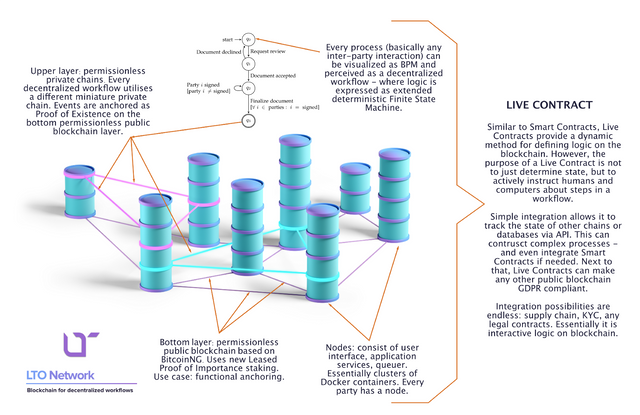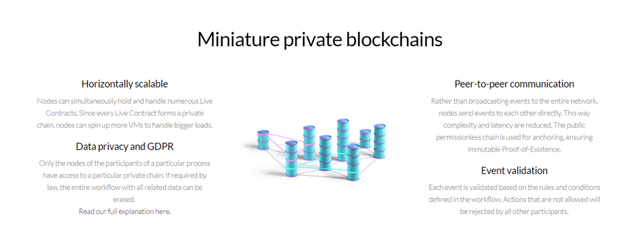LTO Network : Hybrid Blockchain for Decentralized Workflows
What is LTO Network?
The primary mission of this project is to realize a legal system that is fair to all individuals involved. Currency the systems are marred by corruption, with justice being given to the people with the deepest pockets. Legal Things One proposes the use of smarts contracts to eliminate these issues, resulting in a fair legal system. Consequently, the new legal systems will have:
- Independence — clients will participate in a legal system free of intermediaries who besides charging hefty fees usually mislead uninformed individuals.
- Efficiency — live contracts will facilitate the automation of agreements and was without delegation all access to the machines.
- Reduced Fraud — all events and data will be stored in a credible and immutable way, mitigating fraud and eliminating bureaucracy at the same time.
PROBLEM & SOLUTION :
LTO Network’s infrastructure allows different parties, with competing for economic and/or political interests, to work within the same processes without the need to trust one another or a third party. To facilitate this, LTO Network has developed Live Contracts. Similar to a Smart Contract, a Live Contract provides a dynamic method for defining logic on the blockchain. However, the purpose of a Live Contract is not just to determine the state of a process, but to actively instruct humans and computers about the steps it contains.In other words, a Live Contract is a workflow. A workflow is a sequence of related steps or processes that are necessary to complete a particular task. Think of it this way: a workflow has rules, where a certain action triggers another action, and so on .
A workflow is essentially the general template of a business process. For example, consider the workflow of a simple lease agreement approval, in which a document gets (1) drafted, (2) approved and (3) signed. A process is the specific instance of this workflow, so, for example, the lease agreement between parties A and B, which was drafted by an employee of B, approved by the CEO of B, and signed by both parties.A workflow always contains certain logic: the rules mentioned before. Take for example the rule that signing can only come after approval, or that a rejection instead of approval would lead to a re-draft of the agreement.Workflow + workflow rules = Live ContractEssentially, LTO Network handles inter-party Business Process Management on the blockchain. Live Contracts can be applied in a broad spectrum of areas, for example in a supply chain, insurance, healthcare, and KYC procedures. Moreover, the system can be used for legal contracts like lease agreements and NDA contracts. Other use cases can be found here.
Use Case or Token Usage :
The main use case of the token is to enable the anchoring of data hashes on the public chain to ensure immutability and security, through the novel Leased Proof of Importance staking mechanism. Like in the classic PoS mechanism users pay fees with native tokens, which are then re-distributed among network validators.
To ensure that a validator’s rewards are not only contingent on the size of the stake they hold, LTO Network adopted a Proof of Importance concept (similar to NEM). This essentially measures the number of tokens staked against the number of transactions, so that nodes are rewarded for their work in pushing transactions onto the network.The ‘leased’ part allows small token holders and those who hold tokens — but do not want to run a node — to still receive rewards for supporting the network. In project tokenomics there are 4 types of token holders:
- Integrators & Partners — network participants who stake tokens in order to run nodes for transaction validation
- Clients — actors using the network and paying transaction fees, incidentally running nodes
- Passive Stakers — participants who will stake their tokens (potentially through leasing) and run a node to validate transactions
- Non-active holders are non-active participants in the network simply holding tokens
Integrators & Partners, and Clients are both labelled as Participants in the network. It is assumed that at a later stage of the project development participants will hold up to 80% of all tokens and make the core users that will actually employ solutions and add value to the network.
Verdict :
Overall, I like the idea and tokenomics of the project.LTO Network has publicly available testnet on their website and has already launched several successful pilots with several real companies. Mainnet to be launched together with the public sale in January.They have notable partnerships with NuCypher, POA Network, Waves, CPChain. Moreover, they get mass awareness from the leading figures in the industry: ICODrops, MoNoico, Wolf Crypto, and we expect even more. All mentioned above will bring a lot of hype to the project and increase its investment potential.The team is solid and experienced both in development and legal fields.Their Advisors and Partnerships will bring more clients to LTO Network in future.LTO Network will issue ERC20 tokens with their own blockchain tokens (LTO) during the public sale. They can be converted in both ways through the token bridge. LTO Networks’ crowd sale will be conducted through Proportional.
For More Information :
WEBSITE: https://lto.network
TELEGRAM: https://t.me/joinchat/AJWQTUDKtDlsuGHVFb40eQ
WHITEPAPER: https://lto.network/documents/LTO%20Network%20-%20Technical%20Paper.pdf
TWITTER: https://twitter.com/ltonetwork
MEDIUM: https://medium.com/ltonetwork
REDDIT: https://www.reddit.com/r/livecontracts/
YOUTUBE: https://www.youtube.com/channel/UCaHcF-xterKYTKSpY4xgKiw
Author : Raghav
ETH Address : 0x11b2642E17Bf70C834CaA29a97D2030303d07069


